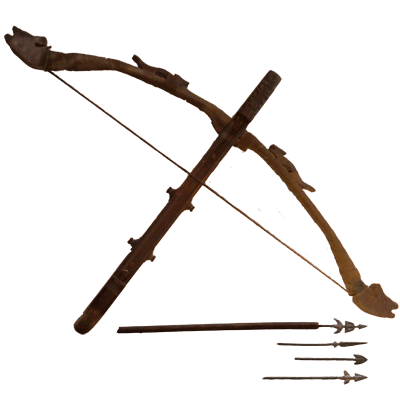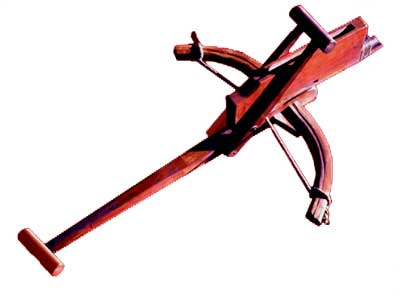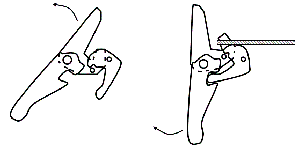

Chinese Invention of the Crossbow |
The use of the bow and arrow for hunting and for war dates back to the Paleolithic period in Africa, Asia, and Europe. It was widely used in ancient Egypt, Mesopotamia, Persia, the Americas, and Europe until the introduction of gunpowder. However, over two thousand years ago in China, the crossbow was invented as an innovation to the basic bow and arrow that extended the use of mechanical hand weapons throughout the world.
Arrowheads were first made of burnt wood, then stone or bone, and then metals. Various woods and bones were used for the bow itself. However, it was not a powerful weapon until the invention of the compound, or composite, bow around 1500 B.C. on the steppes of Central Asia. A composite bow is made of various materials (wood, horn, sinew) glued together so as to increase their natural strength and elasticity. Bows and arrows were among the dominant weapons used by Assyrian chariots, Parthian cavalry, Mongol horsemen, and English longbowmen.
In Europe, crossbow-type artillery pieces were known to the ancient Greeks and were used in 397 BC at Syracuse. Carthagenians in the second century BCE used a hand held crossbow called the scorpion, as it is told (Derry and Williams: A Short History of Technology) that 2,000 of these weapons were handed over to the Romans after the fall of Carthage. Later with the decline of Rome, the crossbow fell into disuse and reappeared again in Europe in the tenth century.
In China, the crossbow revolutionized warfare. A crossbow is a bow set horizontally on a stock. It fires arrows or bolts propelled by the mechanical energy of a taut bowstring. It could be more powerful than the ordinary bow and could fire multiple arrows, darts, or stones. Some designs were slower to fire than the longbow while others were small and useful for close combat.
Chinese literary records (Zhao Ye: The Romance of Wu and Yue) place the invention of the crossbow in China during the Warring States period in the kingdom of Chu about 500 BCE. Many contemporary writers, for example Yang Hong and Zhu Fenghan contend the that the often cited inventor, Ch’in, improved upon a trigger mechanism, and that the crossbow may have existed from the seventh century BCE or even much earlier. Some archeological evidence indicates support the time of development of the crossbow in China to the eneolithic/chalcolithic period around 2000 BCE. One of the earliest representaions is found in the Smith College Virtual Museum of Ancient Inventions.

Wooden-bone Han dynasty Chinese crossbow, second century BCE. Chinese inventors continued to refine the crossbow for hundreds of years, producing a rapid-fire version in the 16th century that carried 10 bolts in a self-contained magazine. 
The figure to the right shows the earliest crossbow artifact, a bronze lock mechanism from the tomb of Yu Wang, 228 BCE. 

ReferencesReturn to History of Chinese Invention and Discovery